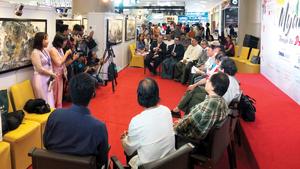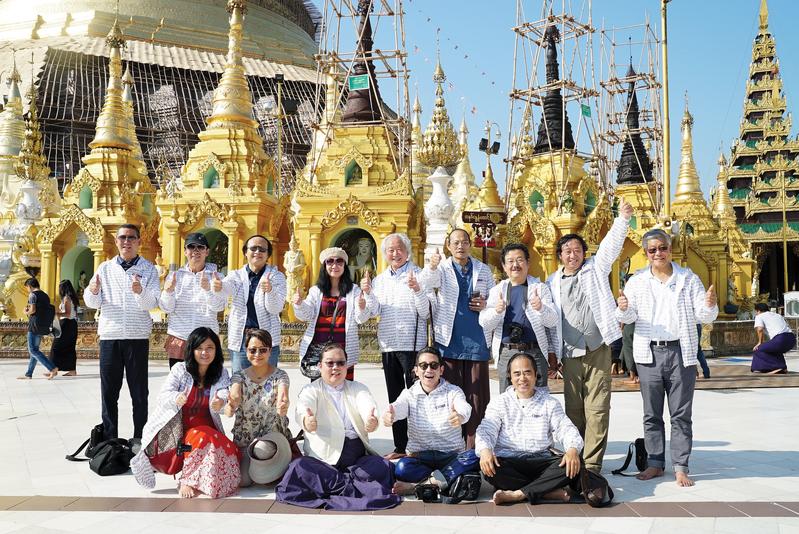Art and cultural exchange program sees Chinese painters injecting diversity into Myanmar’s creative scene, enhancing mutual understanding
 Renowned artists from China and Myanmar participate in the panel discussion on Nov 21 at Junction City in Yangon. (PHOTO PROVIDED TO CHINA DAILY ASIA WEEKLY)
Renowned artists from China and Myanmar participate in the panel discussion on Nov 21 at Junction City in Yangon. (PHOTO PROVIDED TO CHINA DAILY ASIA WEEKLY)
Art and cultural exchange allows two different countries to find common ground culturally, aesthetically and spiritually, which helps deepen mutual understanding and forge intimacy between both sides. And that is precisely what the Belt and Road Initiative encourages.
This was agreed by renowned artists from China and Myanmar at a panel discussion during an exhibition held by China Daily on Nov 21 at Junction City in Yangon, Myanmar.
With the theme Myanmar: Through the Dragon’s Brush, the exhibition rounded up a 10-day Belt and Road art and cultural exchange journey of eight Chinese artists. The program was initiated and organized by China Daily in collaboration with the Chinese Culture and Art Association, and co-organized by RVIPS Publications.
“The purpose of our cultural exchange journey is to better understand Myanmar as a country and its art,” said Chinese artist Dong Xiyuan. “We want to find the quintessence of Myanmar traditional culture.”
After visiting scenic attractions in Yangon, Inle Lake and Mandalay, Chinese artist Zhang Yaoming said: “Everyone looks so calm, just like the (tranquility of) mountains and waters in this country.
“The country did not discard its traditional customs (when seeking modernized development),” added Zhang. “Everything is well preserved, especially the traditional way of living and thinking.”
Admitting that Myanmar does not have a long history of art, local artist Zaw Win Pe said he welcomes artists from China and other countries to bring their works to Myanmar and share their experiences.
Myat Tun Aung, head of the department of painting at the National University of Arts and Culture, Yangon, said he hopes the two countries can work together to cultivate artistic talent. He said he would like to invite Chinese artists to teach in his university so that Myanmar students gain a better understanding of Chinese watercolor painting.
“I hope that there will be more culture and art exchanges between China and Myanmar, to make it possible for Myanmar to shine like a piece of jewelry someday,” said artist Shi Jiangcheng, a well-established Chinese painter.
 The exhibition Myanmar: Through the Dragon’s Brush rounded up a 10-day Belt and Road art and cultural exchange journey. (PHOTO PROVIDED TO CHINA DAILY ASIA WEEKLY)
The exhibition Myanmar: Through the Dragon’s Brush rounded up a 10-day Belt and Road art and cultural exchange journey. (PHOTO PROVIDED TO CHINA DAILY ASIA WEEKLY)
U Aik Htun, chairman of the Shwe Taung Group — the main sponsor of the program — hopes the communication between artists from both sides will inject diversity into Myanmar’s art scene.
“A scenery painting by a Chinese painter could be very different from the works by a Myanmar artist, which could be a far cry from pieces by an Italian painter.
“That’s because artists from different cultures hold varied perspectives and perceptions.”
The goal of the art exchange was to inspire Myanmar artists to absorb diverse art forms and techniques from other countries, and to realize the ultimate art diversity and inclusiveness, added U Aik Htun.
Myanmar lags behind China and other Asian countries in terms of art education, acknowledged U Myint Naing, executive vice-chairman of the Myanmar Chinese Chamber of Commerce. There is only one specialized art institute in the whole country, which is located in Yangon, noted U Aik Htun.
Nevertheless, U Aik Htun added that art education plays a key role in elevating people’s minds and literacy levels, which can propel the progress of a whole society.
Under the BRI, Myanmar as a developing country banks on China’s assistance to improve its art education system, making quality art education more accessible. According to U Myint Naing: “Yunnan University from China is facilitating Myanmar to build a vocational institute that offers art courses.
“Besides, we’ve initiated art exchange programs in partnership with art schools and artist groups from China, with the support of the China-Myanmar Friendship Association.”
The Chinese embassy in Myanmar has also made efforts to deepen the understanding between the two countries through art, remarked Hong Liang, China’s ambassador to Myanmar, who met the group of artists on Nov 15 in Yangon.
For example, a China cultural center was launched in June in Yangon, which held a Chinese fine art exhibition; a landscape painting exhibition was hosted in October by the embassy and the China National Academy of Painting; and a China-Myanmar joint exhibition was co-presented by the embassy and Beijing Fine Art Academy in 2016.
“Art development in Myanmar has relatively lagged behind, which is manifested in their works of art. Their painting skills are far from sophisticated, while their works reflect a sense of rustic simplicity and modesty,” said Hong during the meeting with the artists.
Noting that Myanmar has few academies of art, Hong posed two questions: “Can we (China) support Myanmar to build more art institutes?” and “How can we use our own experience to guide Myanmar to further develop its Buddhist culture?”
Myanmar artists were very impressed by the refined skills of Chinese painters. “I often feel the smiles painted by Chinese painters are real and spontaneous, which we can’t copy,” said Nay Aung Shu, one of Myanmar’s top artists.
Walking around the exhibition, art collector U Zaw Myint said that it was his first time seeing Chinese-style paintings. “It’s marvelous,” he said, appreciating the Chinese artists’ command of using colors.
Khin Zaw Latt, a famous artist in Myanmar, said he had visited galleries in cities in China including Beijing, Shanghai and Xi’an. He is enlightened by contemporary art created in China, he said, which inspires him to add contemporary twists to the Myanmar traditional style.
While art and cultural exchange between Myanmar and China may still be in an early stage, it is gaining momentum, said participants in the art exchange program. To prove this, one should look no further than the newly invented terms bao bo or pauk phaw meaning compatriots, relatives or brotherhood.
“It’s worth noting that the popular term bao bo was coined in the first place to describe the bond between the Chinese and Myanmarese, suggesting that our bond will support each other,” said U Myint Naing from the Myanmar Chinese Chamber of Commerce.
Contact the writers at jenny@chinadailyhk.com


